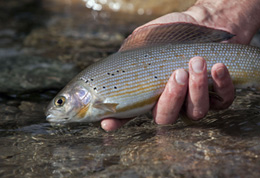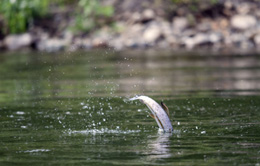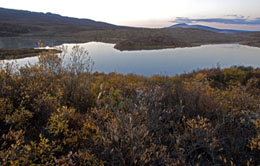Alaska Fish & Wildlife News
October 2011
The Art of Grayling

I’d uttered my good-byes earlier that evening, not aloud, but inwardly, and without sadness. Of course, the grayling wouldn’t have heard me anyway, nor would they have cared. Hardly a fly rod’s length from the lakeshore, the little fish with the sail-like dorsal fins busied themselves sipping blackflies and mosquitoes off the surface. They fed even as reflections of pink tundra hills faded into darkness and the water rings they left behind sparkled with starlight.
Now an astonishing galaxy of faraway planets and suns whirls overhead, and my campsite overlooking the lake glows by the light of my fire. I’m little more than a speck in the wilderness northeast of the Richardson and Denali highways junction of Paxson, and the early-September night wields a hard, cold edge. Concealed by darkness, ptarmigan cackle around me like comedic villains (and judging by the varying placement of their calls, the tundra chickens have me surrounded). The birds are settling into their willow roosts and will soon hush for the night, leaving me alone to stir the campfire coals and savor some solitude and untainted air.
This is the universe as I’ve known it for much of my life. Certainly, the moment represents life as I prefer it, the venue far-flung and sparsely peopled, fresh, wild, pure. When we envision Alaska, we gather images of mountain ranges, glaciers, aurora borealis, caribou, grizzlies and wide-open tundras. These icons and perhaps a thousand others set this place apart.
For an angler, though, nothing defines Alaska more distinctly than grayling. I found them here nearly 50 years ago, when time for me began, in little mountain creeks, roadside lakes, and large glacial rivers. And although I’ve said farewell to them this evening, it is only for the season. I will find them again when the ice, now forming on the pond nearby, trickles away next May.
Dwellers of clear, cold streams and lakes, arctic grayling are elegant creatures easily identified by their uniquely oversized pink- and powder-blue-spotted dorsal fins, purple- and turquoise-sequined flanks, small pouty mouths, and bellies that seem rubbed with gold dust. Anglers adore them for their beauty and for their willingness to strike a variety of spinners, spoons, baits and flies. Grayling are especially renown among fly-fishers for their tendency to rise to dry flies.
Compared to Alaska’s tackle-busting legends – halibut to 459 pounds, world-record king salmon weighing more than 97 pounds, and steelhead topping 42 pounds –grayling are smallish and delicately built; the state record, caught in 2008, weighed a hair over five pounds. As a result, these modest fish never draw trophy-fishing mobs, which is fortunate since the best grayling waters and the environments surrounding them are generally fragile as the fish themselves and intolerant of crowding or heavy pressure.
At a glance, grayling seem cast from an ancient mold: their broad, scalloped scales and webbed, sail-like dorsal fins suggest a living fossil pulled from mudstone and magically brought to life. In fact, arctic grayling are Pleistocene fish, ice age survivors that over the last 10,000 to 20,000 years have spread from North Slope and Yukon River Valley origins to become common throughout Alaska’s Southcentral, Southwestern, Interior and Arctic regions. The only part of the state where they’re not found in abundance is in the Southeastern panhandle.
Today, many excellent grayling fisheries can be reached from Alaska’s highway systems. Good grayling waters include many of the streams and lakes along the Parks, Glenn and Denali highways north of Anchorage in Southcentral; the Tok Cutoff, Richardson, Alaska, and Steese highways outside of the Interior city of Fairbanks; and the Dalton Highway snaking into the Arctic north of Fairbanks. The isolated, abbreviated road system outside of Nome is also known for excellent grayling fishing opportunities.
In camp along the Denali Highway the night is broken by the popping of my campfire and, more subtly, by the hissing of a creek that enters one end of the little grayling lake and exits the other. Those water sounds have me thinking again about grayling, and about time, and the way the two have merged and mingled to form a part of me.

I found them first in the mid-1960s, north of Anchorage in a brook off the Glenn Highway not far from Eureka Summit. The slightly warped bamboo fly rod my father assembled for me easily spanned the brook, allowing me to dangle midstream a dry fly – probably a Black Gnat or Royal Coachman, grayling favorites of my youth that remain powerful medicine today. The grayling in that brook were particularly small, perhaps six or eight inches long, but voracious. I can still picture them leaping from the water for my fly, sometimes two or three fish at once; they made the surface boil. I caught them, too, fish after wriggling, wet, delightful fish, little trophies for a little angler.
A year or two later, when I was old enough to step into the Copper River Basin wilderness each fall to hunt caribou with a close-knit group of family and friends, I was appointed camp fisherman. Only six or seven years old, I took the job seriously. While the grown men busied themselves scoping and hunting for caribou, I would catch grayling on whatever creek was nearby – and in that broad, rolling taiga-and-tundra country grayling water such as Flat Creek, Crooked Creek, or the Little Nelchina River was never far away. I learned along the way to scrape off the scales with a pocketknife and to clean each fish carefully. And when our grizzled camp cook, the patriarch of our group, rolled those grayling in pancake flour and fried them in bacon grease on the Coleman stove, it was as if a four-star restaurant were operating beneath the tarp that served as our mobile cook shack.
Since those very early days, grayling have resurfaced in my life continually. I’ve caught them in the Gold Rush waters of the Klondike country – in streams like Bonanza Creek, North Fork of the Klondike, the Forty-mile River – and in the ice-cold lakes off the Richardson and Denali highways, in the rivers of windswept southwestern Alaska, and in the tea-colored creeks of the Susitna Valley. From an angler’s standpoint, those hours spent fishing for grayling account for a lifetime of Alaska summers. Sometimes, the connection between those fish and me can seem almost spiritual.
Perhaps the best news about grayling is that anglers needn’t be longtime Alaskans to find, catch and appreciate them. All that’s required is a rod and reel – a light fly rod or ultra-light spinning outfit, whichever you prefer – a few bits of tackle, and directions to the nearest grayling stream or lake.
Fly-fishers seeking grayling normally use rods ranging in size from 2- to 6-weight; the lightest rods will handle even the chunkiest fish, but heavier models are sometimes needed to cast across larger streams and lakes. A weight-forward floating line with an 8- or 10-foot-long leader will handle pretty much all Alaska grayling fishing situations, since these fish rarely lie far from the surface.
Ultra-light spinning rods are perfect for catching grayling. Rig them with 4- to 6-pound-test monofilament line and, when adjusting the reel, ease up on the drag to maximize the sport promised in the fishes’ feathery runs and occasional leaps.
In streams, look for grayling in deeper, calmer pools; in lakes, watch for them near stream inlets and outlets and in protected bays. The old saw, “match the hatch,” can be useful in selecting a fly, lure or bait on a given lake or stream. Keep an eye out for grayling food items like mayflies or caddis buzzing low over the waters, salmon spawning in the pools (stray eggs are protein-rich delicacies), or young minnow-size fish schooling near stream banks.
If feeding grayling can be seen breaking the surface – and occasionally, even when no fish are rising – try a dry fly. A sampler of excellent dry fly patterns for grayling might include Adams, Irresistible, Elk Hair Caddis, Humpies, Griffith’s Gnat, Mosquito and, of course, the Black Gnat and Royal Coachman. Fly sizes should range from Nos. 20 to 10. Anglers with spinning rods can successfully cast dry flies for grayling by clipping a small bobber 18 inches or so above the fly. The bobber’s added bulk allows weightless flies to be cast long distances.

Many fly-fishers agree that for every grayling caught on a dry fly, at least twice as many wait below the surface to be caught on nymphs. Good nymph fly patterns include Hare’s Ear, Zug Bug, Bitch Creek, and Pheasant Tail in sizes 18 to 10. These nymphs in bead-head varieties can also be fished under a bobber by anglers with spinning outfits.
Grayling are often suckers for small, flashy spinners – Mepps, Rooster Tail, and Panther Martin brands are a few local staples. Try casting sizes 0 to 2 in a variety of colors. Bait fishers can catch grayling on salmon eggs and mealworms. When salmon are spawning nearby and opportunistic grayling are gobbling up the eggs, salmon-egg fly patterns such as Iliamna Pinkies or beads will effectively match the hatch.
Ancient, elegant and, in a most innocent sense, gullible, grayling are unique characters cut from the rare and precious tapestry that is Alaska. For a few old-timers (and for this one in particular) they compose the first lines of a long, colorful angling story. And for those new to fishing upstream of the 60th parallel north, the little fish promise admission to a world of clean, wild waters and unspoiled vistas.
It’s bedtime at my Denali Highway campsite. The fire has burned down into coals and I’ve run out of willow sticks to feed it. A hard frost glitters on my tent fly nearby; the grayling lake will be frozen by morning.
For now those fish with the flashing scales and tall sail fins will rise and leap only in my heart, where Alaska’s arctic and subarctic waters flow year-round. But I’ll catch them here again next spring, and surely for many seasons to come, when the aurora fades in the light of the midnight sun.
Ken Marsh is an outdoor writer and avid angler who makes his home in Anchorage. He serves as an information officer wiht the sport fish division at the Alaska Department of Fish and Game
Grayling Destinations
Grayling can be caught throughout Alaska’s ice-free season –from roughly May through September in most regions. No matter what Alaska Airlines destination you may plan to visit in Southcentral, Southwestern, Interior or Arctic Alaska, chances are good that grayling fishing waits only a short rental car drive away. A few suggestions include the following:
Anchorage
Take a Hike: Anglers seeking to stretch their legs and enjoy fine grayling fishing along the way need travel no farther than the Chugach Mountains immediately backing Alaska’s largest metropolis. The place is Symphony Lake, a large, emerald-tinted tarn huddled among peaks 3,000 to 4,000 feet tall.
The Symphony Lake trailhead is located a 30-minute drive northeast of Anchorage and anglers willing to hike roughly five miles up the scenic, well-groomed Symphony Lake trail can find superb fishing for arctic grayling. To get started, take the Glenn Highway northeast out of the city to Hiland Road. Drive south on Hiland Road seven miles to South Fork Eagle River Valley Trail Head in Chugach State Park.
Take care to dress for fickle high-country weather that can change quickly from mellow sunshine to chilly rain – or even snow. And bring a camera; the scenery is as unique a lovely as the grayling you’re likely to catch.
On the Road:
North of Anchorage
Grayling streams abound on the Parks and Glenn highways north of Anchorage. On the Parks Highway, fishing starts getting good roughly a 90-minute drive north at Willow Creek. Look for grayling in nearly every decent-sized stream crossed by the highway from here to Denali Park. On the Glenn Highway, grayling can be found in the lakes and rills from Long Lake at Mile 86 to the highway’s terminus at the community of Glennallen.
Fairbanks
Anglers can find great fishing for arctic grayling in many waters traversed by the highways leading to and from Alaska’s Golden Heart city. Popular fishing holes along the Alaska Highway which leads southeast of Fairbanks include the Chena River, Piledriver Slough, Salcha River and Birch Lake.
Northeast of Fairbanks, look for grayling in the Chatanika River, Faith Creek, Birch Creek, and many other streams and lakes.
Subscribe to be notified about new issues
Receive a monthly notice about new issues and articles.
